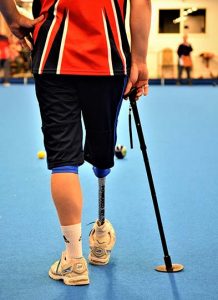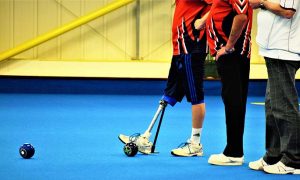INTRODUCTION TO CLASSIFICATION IN BOWLS
Why classify Bowlers with a disability?
In order to compete in International Competition ie; IBD WORLD CHAMPIONSHIPS, COMMONWEALTH GAMES and HOME NATIONS EVENTS a Classification system is essential. These events at which bowlers with disability compete, are governed by the rules of IBD (International Bowls for the Disabled) who in turn are affiliated to The IPC (International Paralympic Committee) both organisations have Sports Specific Classification Systems which is aimed at making the competition as fair as possible for all competitors. The goal is to create a “level playing field”.
History of classification in disabled sport
Each disability group had their own competitions and classification system:
- CPISRA for cerebral palsy and head injuries
- ISMWSF for spinal cord injuries
- ISOD for orthopaedic conditions and amputees
- IBSA for blind athletes
Development of a sport specific classification system
Emphasis has been taken away from the medical diagnosis and placed directly onto the function a person needs to deliver a bowl.
Bowlers are put into classes according to their level of function, rather than according to their diagnosis.
Athletes are assessed using measures of:
- Muscle strength
- Range of joint movement (ROM)
- Co-ordination
- Amputation
- Balance
In the sport specific classification system, a class will usually include a variety of different medical diagnoses with a mixture of ambulant and wheelchair athletes in each.
Bowls Classification is split into three sections;
B1 – B4 is for bowlers with a Visual Impairment (VI’s) who have their own classification procedure that is governed by International Blind Bowls Association (IBBA) International Blind Bowls Association
The International Blind Bowls Association, in line with International Paralympic Committee (IPC) and International Blind Sport Association (IBSA), have adopted the Berkeley Rudimentary Vision Test (BRVT in logMAR units) as the standard method used to evaluate visual acuity.
Visually Impaired Bowls England (VIBE) and Disability Bowls England (DBE) recognise the need for one sight classification system (B1 – B4) for all VIBE & DBE members in line with the laws and guidance from International Blind Bowls Association (IBBA), International Bowls for the Disabled (IBD), World Bowls and Commonwealth Games England.
Please download the Joint procedure & Classification Application forms:
- Joint Visually Impared Bowls England procedure
- VIBE DBE Sight Classification procedure and contacts
- 2023 IBD VI bowls classification forms Feb 2023
B5 – B8 is for bowlers with a physical disability (PD’s). The disability MUST be permanent and irreversible.
Disabilities eligible for classification in the physical disability category include:
Spinal cord injuries, Polio, Amputations, Cerebral palsy, Head injuries, Progressive disorders, e.g. multiple sclerosis, Les autres i.e. achondroplasia, arthrogryposis & Any locomotor disability.
Disabilities not included in the physical system:
When they exist with no other physical impairment, the following conditions do not make a person eligible for IBD classification:
Transplants, Deaf, Diabetes, Epilepsy, Wear and tear due to advancing age, General debilitating disease, Obesity, Osteochondritis, Psychiatric conditions (including conversion disorder), Skin diseases, Haemophilia, Cystic fibrosis, Fibromyalgia, Ehlers Danlos, Myalgic encephalitis, Internal organ dysfunction or absence & Complex regional pain syndrome.
L1 – L3 is for bowlers with a Learning (Intellectual) Disability (LD’s) who have their own classification procedure for DBE events and an International Series between England, Scotland & Wales.
A person is considered to have a Learning (Intellectual) Disability for purposes of determining his or her eligibility to participate in the sport of bowls at a Local, National or International Competition, if that person satisfies any one of the following requirements.
-
- The person has been identified as having a Learning (Intellectual) Disability: defined as ‘a condition of arrested or incomplete development of mind, which is characterized by impairment of skills manifested during the developmental period, which contribute to the overall level of intelligence, i.e. cognitive, language, motor and social abilities’
- In common with other national and international sports organisations, a person is deemed to have a Learning (Intellectual) Disability, if they have a full-scale IQ score of 75 or lower. IQ tests are acknowledged to be limited therefore it is important to gather additional information, to assist in understanding an individual’s abilities. In addition, the individual is usually expected to have significant difficulties with self-care, adaptive behaviour and self-organisational skills. This definition covers adults with autism who also have intellectual Impairment.
The procedure to obtain a Classification is governed by the International Bowls for the Disabled (IBD) with the award given by approved Classification Teams and ratified by the IBD.
- For players with a Visual Impairment a medical diagnosis and sight test is obtained and sent to a Professional Ophthalmic Consultant who decides if a classification can be awarded and in which category. An examination may be required.
- For players with a Physical Disability a medical diagnosis followed by a physical examination involving a series of tests to determine muscle strength; range of movement; co-ordination; amputation & balance are used to determine if a classification can be awarded and in which category.
- For players with Learning (Intellectual) Disabilities. A person’s eligibility can be confirmed by someone who is professionally experienced in what does and does not constitute a learning disability and who is well acquainted with the person who is seeking classification for Indoor Bowls. If there is no hard copy evidence or letter in existence of a person’s Learning disabilities, eligibility can be confirmed for example, by a Psychologist, Doctor, Head Teacher, local learning disability team advisor (local authority), Manager of a care home, CEO of a Learning Impairment specific organisation or Social Worker.
If you have any queries regarding classification please contact info@disabilitybowlsengland.org.uk.”
Minimal Disability
Bowlers are eligible to compete in IBD sanctioned events if they have a physical disability that causes or ought to cause a noticeable impairment of function while bowling.
Physical Disability is any birth defect, injury, surgery, or disease process, which causes a medically evident permanent impairment of physical function.
Disability solely due to mental or psychological causes, or to disorders which could be corrected by the bowler, such as obesity, is not considered eligible for competition, even if it causes noticeable impairment of function while bowling.
Bowler’s and NPC’s responsibility for classification
It is the bowler’s responsibility to be sure that they are officially classified before competing in an IBD sanctioned event,
is the bowler’s responsibility to be sure that they are officially classified before competing in an IBD sanctioned event,
They must either produce a current and valid classification card on registering for an event, or, if they have not been classified, be sure their name is on the schedule for classification at the event.
Bowlers with an R or an N status classification must also ensure that they are on the list to obtain a P classification by an International classifier
N = new classification, not performed by an international classifier
R = review classification, for bowler’s whose condition is likely to change
Eg multiple sclerosis
P = permanent classification, performed by an international classifier
Once a bowler has been classified by an International Classifier, a classification card will be posted out to him/her by the IBD Bowls Classifier.
World Anti-Doping Agency (WADA)
2023 Prohibited List
